Country Americana Sale at Garth's
September 6th, 2013
 Two-piece apothecary or store chest with 63 drawers, pine with old gray paint, 19th century, 81½" high x 87" wide, $3916.
Gasoline sign, single-sided, wood in original blue paint with white letters and black trim, first half of the 20th century, 16" x 86", wear and some losses, $3290.
Patriotic pitcher with “E. Jones” over an American shield lettered “Claremont” and “American Porcelain,” Charles Cartlidge, New York, mid-19th century, molded corn design with gilt accents, 11" high, some wear and crow’s feet, $6756.
Game board in pine with original polychrome paint in a Parcheesi layout, late 19th or early 20th century, single board with breadboard ends, 16½" x 21½", wear and age splits, $6025.
Eagle push toy, carved and painted wood with moving wings, on a wrought-iron frame, early 20th century, 34" long overall, the eagle 16" x 23", worn original paint, small crack in one leg, good working order, $9400.
Diamond in a Square pattern Pennsylvania Amish quilt, Lancaster County, late 19th or early 20th century, solid color wools in rich green and deep purple with muted shades, wool back, hand-quilted designs that include wreaths, a diamond grid, and vining plumes, 76" x 78", mounted in a custom frame, some moth damage to the binding and a few white spots, $5875.
Paint-decorated oval bentwood box with lapped seams attributed to Heinrich Bucher, Berks County, Pennsylvania, late 18th or early 19th century, original design of a flower basket, 6½" high x 15½" wide, paint loss with some touchup, $7520.
Reliable Egg Carrier in original blue paint, stenciled labels for merchant “Strouse & Bros/ Clothing, Hats & Furnishings/ Evansville, Ind.,” and the maker, “Reliable Incubator & Brooder Co. / Quincy, Ill./ Patented Nov. 16 1897,” 11" high x 13½" square, some edge wear, $823.
Eagle Pottery ten-gallon crock with two stenciled eagles, “From W. D. Cooper & Bro. No. 7 Diamond Pittsburgh,” and some freehand cobalt designs, third quarter of the 19th century, 2½" crack, losses to both handles, $10,575.
One-piece bucket bench cupboard in pine with old red paint, 19th century, 83½" high x 71" wide, unfinished sides, $5405. |
Garth’s, Delaware, Ohio
Photos courtesy Garth’s
A Soap Hollow blanket chest took the top price at the country Americana sale held by Garth’s Auctions on September 6 and 7 in Delaware, Ohio. It was a weekend in which painted case furniture did exceedingly well.
The blanket chest, made by John Sala and dated 1868, was in its original red and black paint with stencils that included a melon basket. A manageable size at 26" high x 48" wide, the piece sold within its estimate for $15,275 (includes buyer’s premium).
“It’s selling in the right place,” said Amelia Jeffers, president of Garth’s. “It’s Soap Hollow. We hold the record for it.” That high-water mark stands at $132,250 for a chest of drawers made by Jeremiah Stahl and dated 1867 that was offered by the auction house in February 2005.
“We have a strong audience for painted furniture,” Jeffers added.
Among the highlights were items from the collection of J. Garland Warren of San Marcos, Texas. “He was a guy with a great eye, time, and money,” Jeffers said. About half the lots offered were from Warren’s estate.
The dry sink was among his favorite forms, and he managed to find not only good examples in early paint but also many having unusual forms. Three dry sinks sold for more than $5000 each, while two others went above $3000. The highest bid was for a two-piece high-back version scraped down to an old blue paint over an earlier black. With three upper drawers and two lower doors, it realized $5875.
Painted American furniture in other forms also made an impact. A one-piece bucket bench/cupboard in old red paint, having two paneled doors over a shelf, was $5405. A blind-door cupboard in old cream paint, having an unusual combination of eight paneled doors over a bold scroll-cut skirt, sold for $5288. In old blue paint, a Chippendale mule chest with a lift lid over two false drawers and two working drawers, all on tall bracket feet, brought $4406. A 15-tin pie safe in old brown paint and with punched fylfot designs, the case featuring three doors over one short and one long drawer, all on turned legs, probably of southern origin, realized $3290. A schoolmaster’s desk in old blue paint, the slant lid over two paneled doors, all on tapering square legs, hit $3760.
“I love buyers for great painted country furniture,” Jeffers added. “As long as the paint is right, they’re a little more forgiving on the condition.”
It wasn’t just the paint that had the standing-room-only crowd putting bid paddles in the air both days. A one-piece walnut cupboard with a bold broken-arch pediment over two glazed doors over two drawers over two paneled doors, in a good old surface, sold for $4994. In curly maple, a staple at Garth’s, a chest of drawers with paneled sides and a finished back, believed to have originated in Zoar, Ohio, realized $2169.
The best of the curly maple was a tall-case clock, having not only bold figure to the maple but also to a cherry panel. With a 30-hour wooden movement by Luman Watson of Cincinnati and a case by A. Read and Company of Xenia, Ohio, the circa 1825 clock sold for $11,750.
“It’s screaming curl,” said Jeffers. Everything added up, with “great-looking curl, great figure in that wood, and a great form in the clock, too.”
She added, “The buyer was a collector. She’s going to be willing to reach higher than the dealer audience is and push the price to a retail level. She came determined to get it.”
It was that kind of day, with strong prices not only for the furniture but also in an array of categories.
The best of the stoneware was a ten-gallon merchant’s crock made by Eagle Pottery of Greensboro, Pennsylvania. With two stenciled eagles and lettered “From W. D. Cooper & Bro. No. 7 Diamond Pittsburgh,” it sold for $10,575 on the strength of enthusiastic interest from a number of directions.
“For the size, it had pretty great condition,” said Jeffers. “We had a lot of interest in the crock. At auctions we joke that it only takes two people, but there were a lot more than two…There was a lot of depth to the demand for that one.”
Another eagle form—a push toy with a carved and painted eagle having mechanical wings, all on a wrought-iron base—also drew serious spirited bidding, selling for $9400. The plaything was designed to be pushed across the floor by a single handle. As the wheels turned, they moved rods that flapped the wings. The consignor indicated that his aunt had purchased the item decades ago at an antiques show. It had remained in her basement for years. The family apparently didn’t see the appeal in the toy. “We all thought it was a little weird,” the nephew reportedly said.
Even quilts, which haven’t enjoyed the strongest market in recent years, got more attention than usual. Two Pennsylvania Amish quilts sold for four-figure prices. The better one featured a Diamond in a Square pattern in greens and purples and brought $5875.
“We’ve seen some improvement in the market for sure,” Jeffers said of the quilts. She attributed some of that strength to Ellice Ronsheim, Garth’s textiles specialist.
Also drawing considerable interest was a paint-decorated bentwood box having a design of flowers in a vase, attributed to Heinrich Bucher of Berks County, Pennsylvania. The box’s strong design was tempered by some paint wear. It sold for $7520. “Jeff [Jeffers, Garth’s chief executive officer] believes all day long it’s Bucher, no doubt. Jeff said if it hadn’t had the wear, he believes it would have tripled.”
Advertising also played a significant role both days, with numerous painted wooden signs in the spotlight. Drawing from an extremely active market for petroliana, a single-sided “Gasoline” sign in blue paint with white letters and black trim, 16" x 86", sold for $3290. Other signs turned heads for their whimsical nature, including a 30½" x 23" example illustrated with a red and blue umbrella and lettered “Fine Sale/ of Umbrellas,/ Rain Capes &/ Coats Galoshes.” It brought $1645.
The selection of advertising also included egg crates in old paint, a traditional country form that remains popular with collectors. An egg carrier made by the Reliable Incubator & Brooder Company of Quincy, Illinois, advertising “Strouse & Bros/ Clothing, Hats & Furnishings/ Evansville, Ind.,” in old blue paint, sold for $823. Jeffers attributed the strong bidding to crossover interest from buyers in the market for advertising, country items, and original paint.
Similarly, a Reliable egg crate in mustard paint, promoting clothing and hats from Rist & Conant of Turners Falls, Massachusetts, sold for $764, while a slide-lid box in old red paint with black stenciling for “Fry’s Fine Cut Tobacco” sold for $1645.
Paint also played a significant role when it came to game boards, the best of which featured a Parcheesi layout in strong colors. Made of a single plank with breadboard ends, it sold for $6025.
Buyers looking for a break in the upward swing of prices could find them. Pewter and spatterware continue the struggle to find momentum.
“Pewter is soft right now. It is what it is. I think it speaks to the academic nature of collections and reproductions,” Jeffers said. Ditto for spatterware. “If I had lots of money I’d be buying spatterware. I think it will come back,” she added.
In the meantime, the lower and middle markets have opened somewhat, she noted. Design buyers get part of the credit, as those shoppers are more concerned with a particular look than with filling voids in a collection.
It’s not just smalls that fit that bill. On the second day of the auction, it was a 19th-century trestle table in butternut, nearly 9' long, paired with a set of ten side chairs. The chairs were a nice addition, but it was the table that was of note, sending the lot to $6169.
Originally slated for Garth’s eclectic auction, the table was culled out and placed in the Americana sale, where it drew breakaway bidding because of the combination of design, color, and size. “This was a neat form,” Jeffers said of the table. “The chairs were the chairs were the chairs. The table had a wonderful form, and that size of trestle table was an unusual thing to see.”
For more information, phone Garth’s at (740) 362-4771 or visit (www.garths.com).
|
|
|
|
|
Tall-case clock with 30-hour wooden movement by Luman Watson of Cincinnati and case by A. Read and Company of Xenia, Ohio, circa 1825, curly maple and cherry, the dial lettered “L. Watson Cincinnati,” 91" high, movement is of the period but probably not original to the case, $11,750. |
|
|
|
|
Originally published in the December 2013 issue of Maine Antique Digest. © 2013 Maine Antique Digest
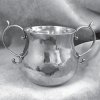
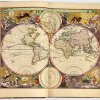




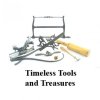


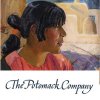



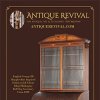

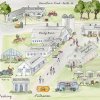



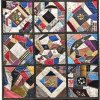
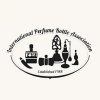


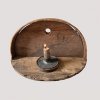
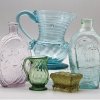







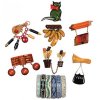








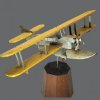









 Soap Hollow paint-decorated blanket chest by John Sala, dated 1868, original red and black paint with stenciled decoration that includes a melon basket, “JS 1868” and “Manufactured by John Sala,” 26" high x 48" wide, some paint wear, damage to front lid molding, replaced pulls, old hinge repairs, $15,275.
Soap Hollow paint-decorated blanket chest by John Sala, dated 1868, original red and black paint with stenciled decoration that includes a melon basket, “JS 1868” and “Manufactured by John Sala,” 26" high x 48" wide, some paint wear, damage to front lid molding, replaced pulls, old hinge repairs, $15,275. Two-piece dry sink in pine with worn old blue paint, mid-19th century, 54" high x 54" wide, yellow grained paint removed to reveal the blue that is over an earlier black paint, $5875.
Two-piece dry sink in pine with worn old blue paint, mid-19th century, 54" high x 54" wide, yellow grained paint removed to reveal the blue that is over an earlier black paint, $5875.
 Folky dry sink in pine with old red paint, 19th century, scalloped backsplash, 35" high x 66" wide, age splits, repair, replaced pulls, $5288.
Folky dry sink in pine with old red paint, 19th century, scalloped backsplash, 35" high x 66" wide, age splits, repair, replaced pulls, $5288. One-piece walnut cupboard with a bold broken-arch pediment, 19th century, 83½" high x 45" wide, good old surface, one upper door sagging, pull replaced with a latch, $4994.
One-piece walnut cupboard with a bold broken-arch pediment, 19th century, 83½" high x 45" wide, good old surface, one upper door sagging, pull replaced with a latch, $4994.




